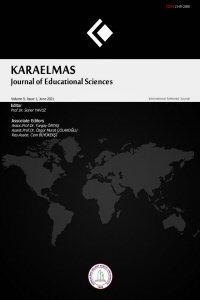Yabancı Dil Eğitiminde Öz-Değerlendirmenin Gücü
Kendi gelişimlerini görmelerini sağladığı için ve kişisel ihtiyaçlarına cevap verdiği için özerk dil öğreniminde özdeğerlendirmenin temel dil öğretim stratejisi olduğu yaygın olan bir görüştür. Son yirmi yıldır, öğrencileri öz-değerlendirme yapabilmeleri için eğitmek yaygın olarak kabul görmüştür ve birçok çalışmada da araştırılmıştır. Bu bilgiler ışığında, mevcut çalışma öz-değerlendirmenin İngilizce öğrenimine karşı tutumları ve yeterlilikleri artırması potansiyelini araştırmayı hedeflemiştir. Çalışmaya 2016-2017 akademik yılında Bülent Ecevit Üniversitesi Yabancı Diller Yüksekokulu Temel İngilizce Bölümü’nde öğrenim görmekte olan 265 öğrenci katılmıştır. Çalışmada test-tekrar test tekniği kullanılmıştır. Sonuçlar özdeğerlendirmenin öğrencilerin İngilizce öğrenmeye karşı tutumları üzerinde etkileyici bir fak yarattığını göstermiştir. Özdeğerlendirmenin Avrupa dil portfolyosu, öğrenme stili envanteri ve ünite odaklı kazanım listesi aracılığıyla geliştirildiğinin uygulamaları aktarılmıştır. Bu çalışma ayrıca öz-değerlendirmenin üniversite seviyesinde uygulanması ile ilgili pratik öneriler sunmaktadır
Anahtar Kelimeler:
Öz-Değerlendirme, Dil Öğrenimi, Avrupa Dil Portfolyosu, Öğrenme Stili Envanteri, Ünite Odaklı Kazanım Listesi
The Power of Self-Assessment in Foreign Language Education
It is widely accepted that self-assessment is a key learning strategy for autonomous language learning, enabling students to monitor their progress and relate learning lo individual needs. Since the last two decades, training students in self-assessment has gained increasing currency and has been investigated in a considerable number of studies. In line with this background, the present study aimed at investigating the potential of self-assessment ability and attitudes towards studying English. Two hundred sixty five students studying at Bülent Ecevit University School of Foreign Languages Department of Basic English in the 2016-2017 academic year participated in the study in a pre-test post-test control group design. The results indicated a significant effect of self-assessment in creating positive outlooks toward English language learning. The implications of selfassessment in ELT by the European Language Portfolio are discussed. This article will also make some practical suggestions for carrying out self-assessment at university level
Keywords:
Self-Assessment, Language Learning, European Language Portfolio, Learner Style Inventory, Unit Based Checklist,
___
- Bloxham, S. & Boyd, P. (2007). Developing effective assessment in higher education: A practical guide. Open University Press: New York.
- Boud, D. (1995). Enhancing learning through self-assessment. Kogan Page: London, England.
- Boud, D. & Falchikov, N. (1989). Quantitative studies in student self-assessment in higher education: A critical analysis of findings. Higher Education, 18, 529-549.
- Council of Europe (2001). Common European Framework of References for Languages: Learning, teaching, assessment. Cambridge University Press: Cambridge.
- Garrett, J., Alman, M., Gardner, S., & Born, C. (2007). Assessing students' metacognitive skills. American Journal of Pharmaceutical Education, 71(1). Retrieved from http://www.ncbi.nlm.nih.gov/pmc/articles/PMC1847545/
- Glover, P., Mirici, İ. H., & aksu, M. B. (2005). Preparing for the European Language Portfolio: Internet connections.
- Turkish Online Journal of Distance Education, 6(1), [Online: http://tojde.anadolu. Edu.tr/yonetim/icerik/makaleler/179-published.pdf Retrieved on 02 January 2016]
- Holec, H. (1981). Autonomy and foreign language learning. Oxford: Pergamon. (First published 1979, Strasbourg: Council of Europe)
- Imel, S. (2002). Metacognitive skills for adult learning: Trends and issues alert no. 39. Columbus, OH: ERIC Clearinghouse on Adult, Career, and Vocational Education.
- Little, D. (2005). The common european framework and the european language portfolio: involving learners and their judgments in the assessment process. Language Testing, 22(3), 320-336.
- Little, D & Perclova R. (2001). The European Language Portfolio: A guide for teachers and teacher trainers. Strasbourg: Council of Europe. Retrieved on 4th October 2005, from http://culture2.coe.int/portfolio//documents/ELPguide_teachertrainers.pdf.
- Maslovaty, N. &Kuzi, E. (2002). Promoting motivational goals through alternative or traditional assessment. Studies in Educational Evaluation, 28(3), 199 222.
- Mirici, İ. H. (2008). Development and validation process of a European language portfolio model for young learners. Turkish Online Journal of Distance Education, 9(2), 26-34. [Online: http://tojde.anadolu. Edu.tr/yonetim/icerik/makaleler/399-published.pdf Retrieved on 03 January 2016]
- Mirici, İ. H. (2014). The Common European Framework of Reference for Languages (CEFR) and the European Language Portfolio (ELP) in S. Çelik (Ed.)
- Mirici, I. H. (2015). Contemporary ELT practices across Europe and in Turkey. International Journal of Language Academy, 3(4), 1–8.
- Mirici, İ. H. (2015). European policy and practices in training foreign language teachers [in Turkish]. Hacettepe University Journal of Education [Hacettepe Üniversitesi Eğitim Fakültesi Dergisi], 30(4), 42-51.
- Mirici, İ. H. & Kavaklı, N. (2017). Teaching the CEFR oriented practices effectively in the M.A. program of an ELT department in Turkey. International Online Journal of Education and Teaching, 4(1). 74-85. http://iojet.org/index.php/IOJET/article/view/159/151
- Pope, N. (2005). The impact of stress in self- and peer assessment. Assessment and Evaluation in Higher Education, 30(1), 51 63.
- Sadler, P. M. (2006). The impact of self- and peer-grading on student learning. Educational Assessment 11(1), 1 31.
- Tan, K. H. K. (2007). Qualitatively different ways of experiencing student self-assessment. Higher Education Research & Development, 27, 15-29.
- ISSN: 2148-2888
- Yayın Aralığı: Yılda 2 Sayı
- Başlangıç: 2013
- Yayıncı: Zonguldak Bülent Ecevit Üniversitesi
Sayıdaki Diğer Makaleler
Miyase TUTAR, Murat KURT, Orhan KARAMUSTAFAOĞLU
İnternet Teknolojilerinin Yükseköğretime Etkileri
Grup Değişmezliği Özelliğinin Farklı Eşitleme Yöntemlerinde İncelenmesi
Hande TANBERKAN SUNA, Şeref TAN
Evrensel Tasarıma Dayalı Öğrenme ve Evrensel Olarak Tasarlanmış Eğitim Programlar
Ortaokul Öğrencilerinin Sayı Duyularının Okul Türleri Açısından İncelenmesi
Çeşitlilik ve Sosyal Adalet Ölçeği: Geçerlik ve Güvenirlik Çalışması
